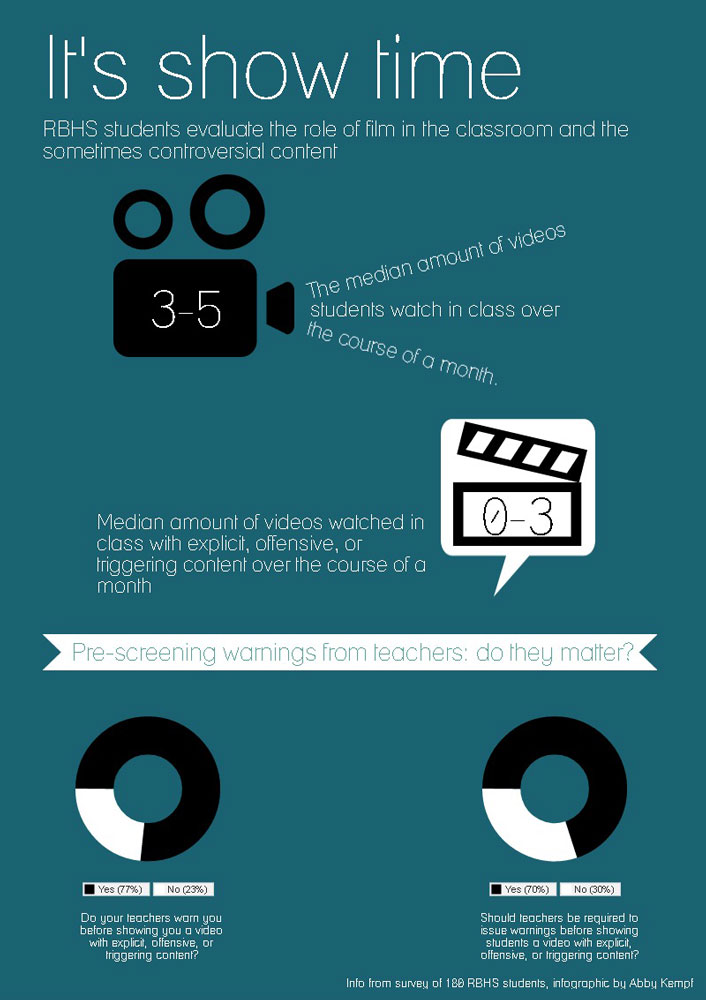Administration clarifies guidelines for selecting videos to play in classroom
In a Nov. 21 email, Dr. Jennifer Rukstad, RBHS principal, set specific guidelines for teachers to choose whether or not a video is appropriate to be shown to their students.
“The communication to our teachers was prompted by the latest of the occasional parent concern over video content shown in a class,” Rukstad said. “I realized in communications with the teacher and parent in this case that I hadn’t provided guidelines for video content. It seemed a good time to do so. The theme of my guidance to teachers was to communicate the reason a certain piece of content would be used if there might be a question of appropriateness and to give options to students and families who would choose not to view.”
The guideline Rukstad sent out provides questions that teachers need to ask themselves before showing a video. These questions basically assess the appropriateness, offensiveness and the level of discomfort students might feel watching the video. But Rukstad understands that no matter what precautions are taken, someone could still be bothered.
“The question of what is too offensive, graphic or explicit is very relative, which is what makes this a complicated issue,” Rukstad said. “Our teachers are extremely responsible in their choices of content. That doesn’t mean that certain content, carefully chosen, might also be unacceptable to any given student or parent.
Controversy over what is offensive and what is not is never ending. This controversy is not what Rukstad is concerned, so much as what content is too violent or graphic for students, according to their stage in brain development. Rukstad said in the email that adolescent brains can not differentiate between fact and fiction when shown content that is violent, offensive, or otherwise R rated. 
Professor Jacqueline Woolley of the University of Texas has done research proving that the frontal lobe of the brain is not done developing until age 25. The frontal lobe is a decision making center, and if a student perceives something to be alright in a film, they may not be able to discern that it is not alright in their real lives.
AP Literature teacher Neal Blackburn sees the merit in Rukstad’s requests as he deals with how to discuss heavy topics with his students.
“I think more than anything you have to keep in mind the age group of the folks that you have and the fact that there are lots of kids that come from families who have never seen a rated R movie. So I think that rating does play a significant role,” Blackburn said. “Also being a parent of a current sophomore here, too. I look at it like ‘O.K., is it significantly worse than what she is exposed to on a day to day basis as she walks the halls of high school?’ If it’s something that I think is, or the subject matter is something that I would prefer to be able to have a conversation with my [own] kids about, I think those are the kinds of things that are a lot more questionable.”
Junior Wendy Zhang said last year her class watched a movie that had some pornographic images that may have shocked students.
“Last year in AP World we watched a film called ‘To Live,’ and it had some explicit, graphic visuals so I could see how some people may not feel comfortable with that,” Zhang said. “They did warn us, but still it wasn’t what you would expect, some people may not have taken the warning seriously and stayed and then felt uncomfortable.”
Zhang said the choice of movie was not imperative to the class; another film without these images would have gotten the exact same point across.
“It definitely wasn’t necessary to show that video. It gave some insight to communist China, but they could have skipped the scene,” Zhang said.
The use of permission slips when a teacher feels that rated R material, or otherwise offensive content, is absolutely necessary to show also avoids exposing an unsuspecting student to explicit content.
“The guidelines did not include anything about parent permission slips, but that would be an appropriate practice if a teacher chose that to be the method by which they communicated with parents.” Rukstad said.
Rukstad also pushed alternative assignments to watching potentially offensive videos in her guidelines. Blackburn has utilized this method in his classroom so students do not feel excluded or like they are at a disadvantage to their classmates.
“With my AP [Literature] class last year we read ‘In Cold Blood’ by Truman Capote and watched excerpts from the movie Capote, which is nominated for several Oscar Awards, but since I had mostly seniors, and most were already 18, I told them, ‘You have the opportunity to opt out if the topic is something that you feel uncomfortable with and I would just like you to look some things up regarding Capote,’” Blackburn said. “If I had students younger than that, [I] haven’t really sent a formal letter, that needs to be signed, but [I] send emails home to parents, a blanket email, saying you can opt out.”
By Abby Kempf
Has a teacher ever played a video in class that you found too offensive for a school setting? Do teachers need to worry about being offensive when selecting videos, or purely worry about the quality of the lesson given by the video?
LATEST NEWS
- RBHS holds successful night of percussion
- Not even water?
- Solar eclipse to pass through Missouri, April 8
- How CPS is organized: a guide
- City of Columbia to hold school board election April 2
- Youth Election Participants to assist in upcoming municipal election
- City of Columbia hosts first Community Engagement Session for McKinney Building, hopes to gain public insight on the structure’s future
- RBHS Track Team Opener at Battle Gallery
- March Mathness Photo Gallery
- RBHS varsity girls’ basketball beats Cor Jesu Academy 60-51 in Final Four





















































































